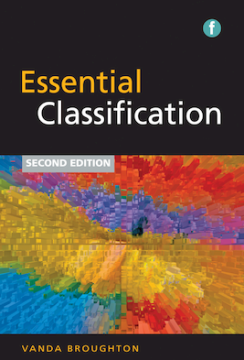
Additional Information
Book Details
Abstract
Classification is a crucial skill for all information workers involved in organizing collections. This new edition offers fully revised and updated guidance on how to go about classifying a document from scratch. Essential Classification leads the novice classifier step by step through the basics of subject cataloguing, with an emphasis on practical document analysis and classification. It deals with fundamental questions of the purpose of classification in different situations, and the needs and expectations of end users. The reader is introduced to the ways in which document content can be assessed, and how this can best be expressed for translation into the language of specific indexing and classification systems. Fully updated to reflect changes to the major general schemes (Library of Congress, LCSH, Dewey and UDC) since the first edition, and with new chapters on working with informal classification, from folksonomies to tagging and social media, this new edition will set cataloguers on the right path. Key areas covered are: the need for classification, the variety of classification, the structure of classification, working with informal classification, management aspects of classification, and classification in digital space. This guide is essential reading for library school students, novice cataloguers and all information workers who need to classify but have not formally been taught how. It also offers practical guidance to computer scientists, internet and intranet managers, and all others concerned with the design and maintenance of subject tools.
Broughton’s book is an essential resource for library science students interested in cataloging and metadata, as well as an asset to librarians and staff in a cataloging or metadata department.
Wanda K. Gunther
University of North Carolina at Chapel Hill
Technical Services Quarterly
Classification is a crucial skill for all information workers involved in organizing collections. This new edition offers fully revised and updated guidance on how to go about classifying a document from scratch.
Essential Classification leads the novice classifier step by step through the basics of subject cataloguing, with an emphasis on practical document analysis and classification. It deals with fundamental questions of the purpose of classification in different situations, and the needs and expectations of end users. The reader is introduced to the ways in which document content can be assessed, and how this can best be expressed for translation into the language of specific indexing and classification systems.
Fully updated to reflect changes to the major general schemes (Library of Congress, LCSH, Dewey and UDC) since the first edition, and with new chapters on working with informal classification, from folksonomies to tagging and social media, this new edition will set cataloguers on the right path. Key areas covered are:
- The need for classification
- The variety of classification
- The structure of classification
- Working with informal classificatio
- Management aspects of classification
- Classification in digital space.
...this lucid book of classification knowledge in pellucid prose and engaging style can easily be described as the best one as of today.
M.P. Satija
Library Progress International
Broughton’s Essential Classification, Second Edition, is a sound work, expertly written and accessible to the beginner without being tedious for those more knowledgeable of classification systems. For those lacking the first edition or otherwise in need of adding a work on classification to their collection, this book comes highly recommended.
Bobby Bothmann
Metadata & Emerging Technologies Librarian, Minnesota State University
Cataloging & Classification Quarterly
Vanda Broughton MA DipLib is a Senior Lecturer in the Department of Information Studies at University College London (UCL), and Programme Director for the MA in Library and Information Studies Programme. She has taught, written and led training courses on classification for many years. She is Editor of the Bliss Bibliographic Classification 2nd edition and Associate Editor of the Universal Decimal Classification. She is the author of two other Facet titles, Essential Library of Congress Subject Headings and Essential Thesaurus Construction.
Both enjoyable and exhaustive in its coverage, Essential Classification is an excellent introduction to the theory behind classification, the main types and examples of classification schemes in wide usage and the practical considerations of applying them to a collection.
Jennifer May
Kingston University
Library and Information Research
